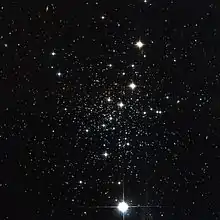Palomar 12
Palomar 12 is a globular cluster in the constellation Capricornus.
| Palomar 12 | |
|---|---|
 Palomar 12 by Hubble Space Telescope, 3.36′ view | |
| Observation data (J2000 epoch) | |
| Class | XII |
| Constellation | Capricornus |
| Right ascension | 21h 46m 38.84s[1] |
| Declination | –21° 15′ 09.4″[1] |
| Distance | 63.6 ± 2.9 kly (19.50 ± 0.89 kpc)[2] |
| Apparent magnitude (V) | 11.99 |
| Apparent dimensions (V) | 17′.4 |
| Physical characteristics | |
| Mass | 1.59×104[3] M☉ |
| Radius | 162 ± 8 ly[4] |
| Metallicity | = –0.85[3] dex |
| Estimated age | 6.5 Gyr[5] |
| Notable features | Probably extragalactic |
| Other designations | GCl 123[6] |
First discovered on the National Geographic Society – Palomar Observatory Sky Survey plates by Robert George Harrington and Fritz Zwicky,[7] it was catalogued as a globular cluster. However Zwicky came to believe this was actually a nearby dwarf galaxy in the Local Group. It is a relatively young cluster, being about 30% younger than most of the globular clusters in the Milky Way.[2] It is metal-rich with a metallicity of [Fe/H] ≈ -0.8.[5] It has an average luminosity distribution of Mv = -4.48.[8]
Based on proper motion studies, this cluster was first suspected in 2000 to have been captured from the Sagittarius Dwarf Elliptical Galaxy (SagDEG) about 1.7 Ga ago.[9] It is now generally believed to be a member of that galaxy.[5] It is estimated to be 6.5 Gyr old.[5]
See Also
References
- Goldsbury, Ryan; et al. (December 2010), "The ACS Survey of Galactic Globular Clusters. X. New Determinations of Centers for 65 Clusters", The Astronomical Journal, 140 (6): 1830–1837, arXiv:1008.2755, Bibcode:2010AJ....140.1830G, doi:10.1088/0004-6256/140/6/1830.
- Rosenberg, A.; et al. (1998), "Young Galactic globular clusters II. The case of Palomar 12", Astronomy and Astrophysics, 339: 61–69, arXiv:astro-ph/9809112, Bibcode:1998A&A...339...61R.
- Boyles, J.; et al. (November 2011), "Young Radio Pulsars in Galactic Globular Clusters", The Astrophysical Journal, 742 (1): 51, arXiv:1108.4402, Bibcode:2011ApJ...742...51B, doi:10.1088/0004-637X/742/1/51.
- distance × sin( diameter_angle / 2 ) = 162 ly. radius
- Geisler, Doug; et al. (September 2007), "Chemical Abundances and Kinematics in Globular Clusters and Local Group Dwarf Galaxies and Their Implications for Formation Theories of the Galactic Halo", The Publications of the Astronomical Society of the Pacific, 119 (859): 939–961, arXiv:0708.0570, Bibcode:2007PASP..119..939G, doi:10.1086/521990.
- "Cl Pal 12". SIMBAD. Centre de données astronomiques de Strasbourg. Retrieved 2006-11-16.
- Abell, George O. (1955). "Globular Clusters and Planetary Nebulae Discovered on the National Geographic Society-Palomar Observatory Sky Survey". Publications of the Astronomical Society of the Pacific. 67 (397): 258. Bibcode:1955PASP...67..258A. doi:10.1086/126815.
- van den Bergh, Sidney (July 2007). "The Luminosity Distribution of Globular Clusters in Dwarf Galaxies". The Astronomical Journal. 134 (1): 344–345. arXiv:0704.2226. Bibcode:2007AJ....134..344V. doi:10.1086/518868.
- D. I. Dinescu; S. R. Majewski; T. M. Girard; K. M. Cudworth (2000). "The Absolute Proper Motion of Palomar 12: A Case for Tidal Capture from the Sagittarius Dwarf Spheroidal Galaxy". The Astronomical Journal. 120 (4): 1892–1905. arXiv:astro-ph/0006314. Bibcode:2000AJ....120.1892D. doi:10.1086/301552.
External links
| Wikimedia Commons has media related to Palomar 12. |
- Simbad reference data
- SEDS: Palomar 12, Capricornus Dwarf
- Palomar 12 on WikiSky: DSS2, SDSS, GALEX, IRAS, Hydrogen α, X-Ray, Astrophoto, Sky Map, Articles and images
- NASA Astronomy Picture of the Day: Palomar 12 (19 February 2015)

